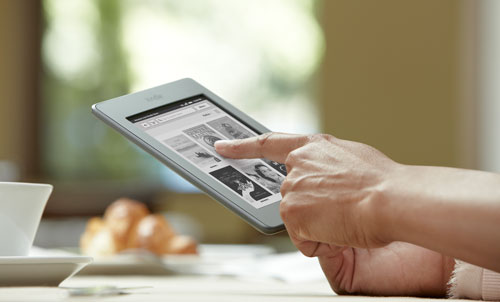
Online retailer Amazon.com unveiled three new Kindles in September: the Kindle Fire, its first entry into the competitive world of tablet computing; the fourth generation of its basic e-reader; and the new touch-based reader, aptly named the Kindle Touch.
Pitched as the top of the e-ink range, the Kindle Touch isn’t the first touch-based e-reader, but it is one of the best.
Available for US$99 in the US — for the advertising-subsidised model; the ad-free version is $139 — the Kindle Touch is only $20 more than the equivalent basic Kindle. Other than the touch functionality, the main difference between the Touch and its cheaper, button-dependent cousin is that the Touch has only two physical buttons, the power/lock button at the bottom and a home button centred beneath the display.
Tapping in the top 2cm of the screen brings up options that vary depending on whether you’re on the home screen, in the browser or reading a book.
Users can turn pages by tapping the screen — the bulk of which is dedicated to turning to the next page while a few centimeters on the left of the screen can be tapped to turn back a page — or by swiping a finger over it. The idea is that readers should be able to read with one hand with ease.
It’s when it comes to entering text or other, more intricate tasks that the touch interface is less impressive. Because the e-ink display takes a moment to refresh, typing or changing the keyboard from lower- to uppercase, or from letters to symbols, is disconcerting and a little tedious.
 Thankfully, aside from browsing the Kindle Store, this shouldn’t be a problem, unless of course you’re that rare breed of person who uses the Kindle’s browser extensively.
Thankfully, aside from browsing the Kindle Store, this shouldn’t be a problem, unless of course you’re that rare breed of person who uses the Kindle’s browser extensively.
We reviewed the Wi-Fi-only model of the Kindle Touch. The 3G version costs $149 ($189 without ads).
As far as ports go, there’s a microUSB port for charging or transferring data and a 3,5mm headphone jack. As with other e-ink Kindles, and to keep the cost down, Amazon has opted not to include a mains adapter for the microUSB connector, choosing instead to sell it as an accessory. Charging it from a PC is no problem.
The device is light at 213g and only marginally larger than the third-generation Kindle. It includes 4GB of internal storage, of which around 3GB is useable.
The six-inch touch display offers 600×800-pixel resolution at 167 pixels/inch and like all e-ink Kindles the Touch isn’t backlit. Users can opt to purchase a case with a built-in light that draws power from the Kindle Touch via two contacts on its rear that sit near the built-in speakers. It’s worth the purchase.
One of the best features of Kindles in general is the ability to look up words on the fly and make notes or highlight passages as you read. Amazon has now gone one step further by adding “X-Ray”, a feature that allows you to look for characters, keywords or similar information throughout a book — at least, for those that support the feature — making it easier to jog your memory if it’s been a while since you last picked it up.
Though it was inevitable that touch functionality would make its way to the Kindle, on the whole the experience is somewhat underwhelming and it’s difficult to find any really compelling reasons to fork out the extra money for the Touch over its cheaper counterpart, particularly considering that when it comes to its primary use — reading text — the experience is identical.
Some users, in fact, may prefer the button-based interface, not only because they’re accustomed to it, but because touch displays demand frequent cleaning and can result in inadvertent selections far more easily than devices with physical buttons.
The Kindle Touch is a natural evolution of Amazon’s e-reader, but it’s hardly a revolutionary change. We’d stick to the cheaper, non-touch model for now, especially since Amazon doesn’t ship the Touch to SA yet, so you’ll need to buy it from an importer. — Craig Wilson, TechCentral
- Review unit supplied by Wantitall
- Subscribe to our free daily newsletter
- Follow us on Twitter or on Google+ or on Facebook
- Visit our sister website, SportsCentral (still in beta)




